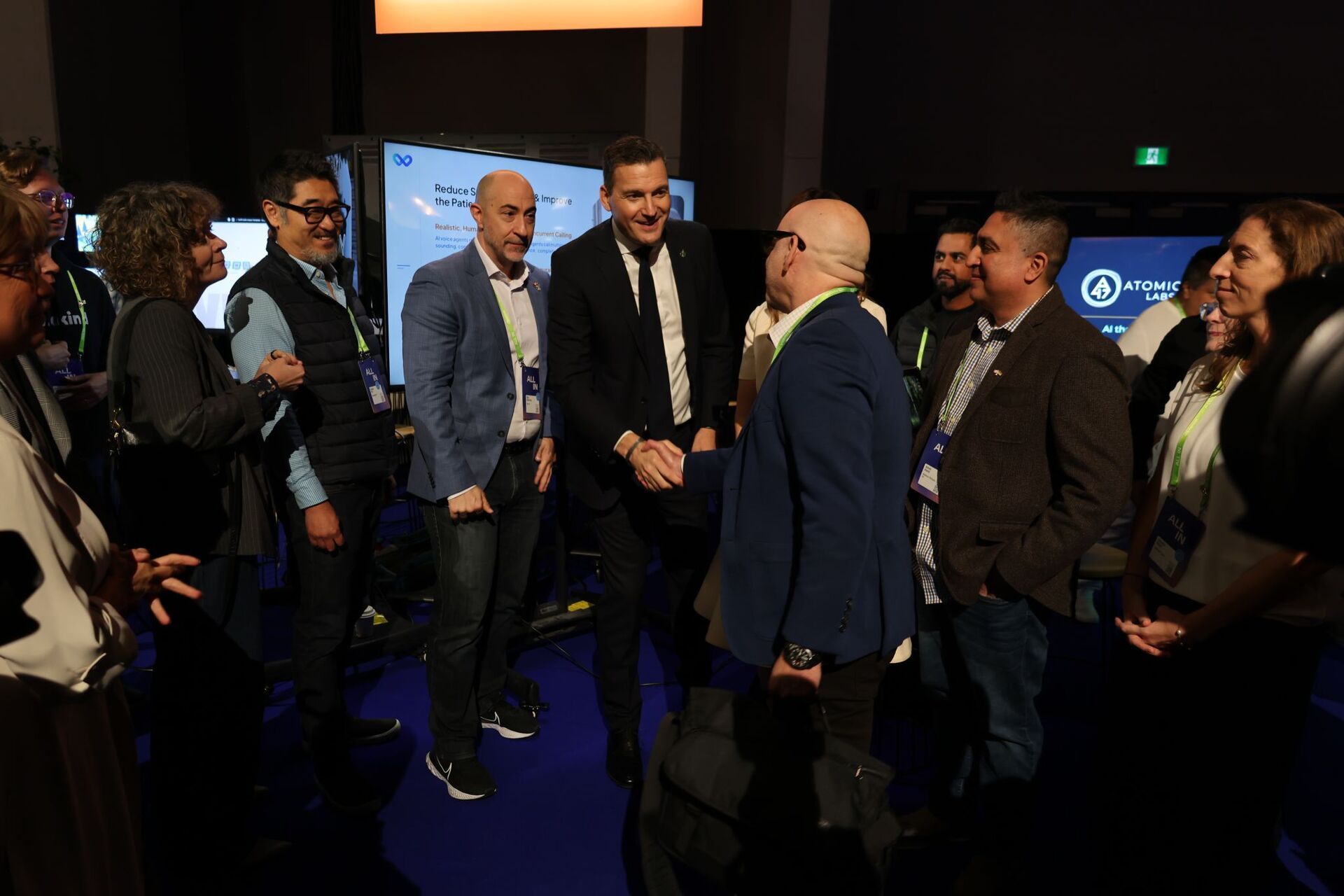
Minister Evan Solomon (centre) greets members of B.C.’s delegation to Montreal’s ALL-IN conference in September 2025. (Credit: AInBC / Paul Shay)
On an otherwise ordinary November afternoon — squeezed between back-to-back meetings and half-drunk coffees — I found myself toggling between two conversations that shouldn’t have felt connected, but did.
The first was with Louise Turner, executive director of the Quantum Algorithms Institute, the nerve centre of B.C.’s emerging quantum ecosystem. The second was with Rob Goehring, executive director of the Artificial Intelligence Network of British Columbia (AInBC), who tracks the province’s AI momentum with the intensity of someone watching a weather system break over the horizon.
Individually, each conversation mapped out the future of one frontier industry. Taken together, they revealed something more startling: British Columbia — quietly, improbably — is standing at the precise intersection of the world’s two most transformational technologies: artificial intelligence and quantum computing.
This is not how B.C. usually appears in national narratives. We’re the film-service province. The mountains-and-lifestyle province. The place Toronto sometimes remembers exists.
But beneath that surface, something else has been happening: decades of research, talent development and corporate experimentation have quietly accumulated into a dual advantage — one in AI, one in quantum — now being accelerated by the geopolitical shockwaves of 2025.
And according to both Turner and Goehring, the next three to five years will determine whether B.C. becomes a global leader in these technologies — or watches others seize the opportunity.
A new geopolitical weather system
Turner didn’t start with quantum when I asked about the recently proposed — and now official — federal budget. She started with tariffs.
“When Trump began imposing tariffs again, the world shifted,” she told me. “It became clear that our relationship with the world has changed quite significantly. Economically, if we’re going to survive, we can’t just assume we have this big market next door to sell into.”
To Turner, the centre of gravity moved almost overnight. Where Canada once relied on the U.S. as a stable export market and partner in technology development, the second Trump administration — combined with renewed protectionism and reordered supply chains — has pushed Canada into a new posture.
The 2025 federal budget is the clearest initial expression of that, Turner says. It commits $925.6 million over five years toward sovereign AI compute — Canadian-controlled infrastructure for training and deploying advanced models — and another $334 million to strengthen Canada’s quantum ecosystem. These numbers may seem abstract, but to Turner and Goehring they signify the same conclusion: Canada is trying to build the technological foundation it can no longer assume access to.
“This budget is foundational,” Goehring said. “Compute doesn’t solve everything, but it removes one of the biggest barriers to scaling.”
Turner sees it as Canada signalling that quantum is no longer theoretical or optional. “Quantum is what economists call an ‘infant industry,’” she said. “Very few countries are taking it seriously. Canada is saying: yes, this matters.”
And British Columbia has already done the groundwork.
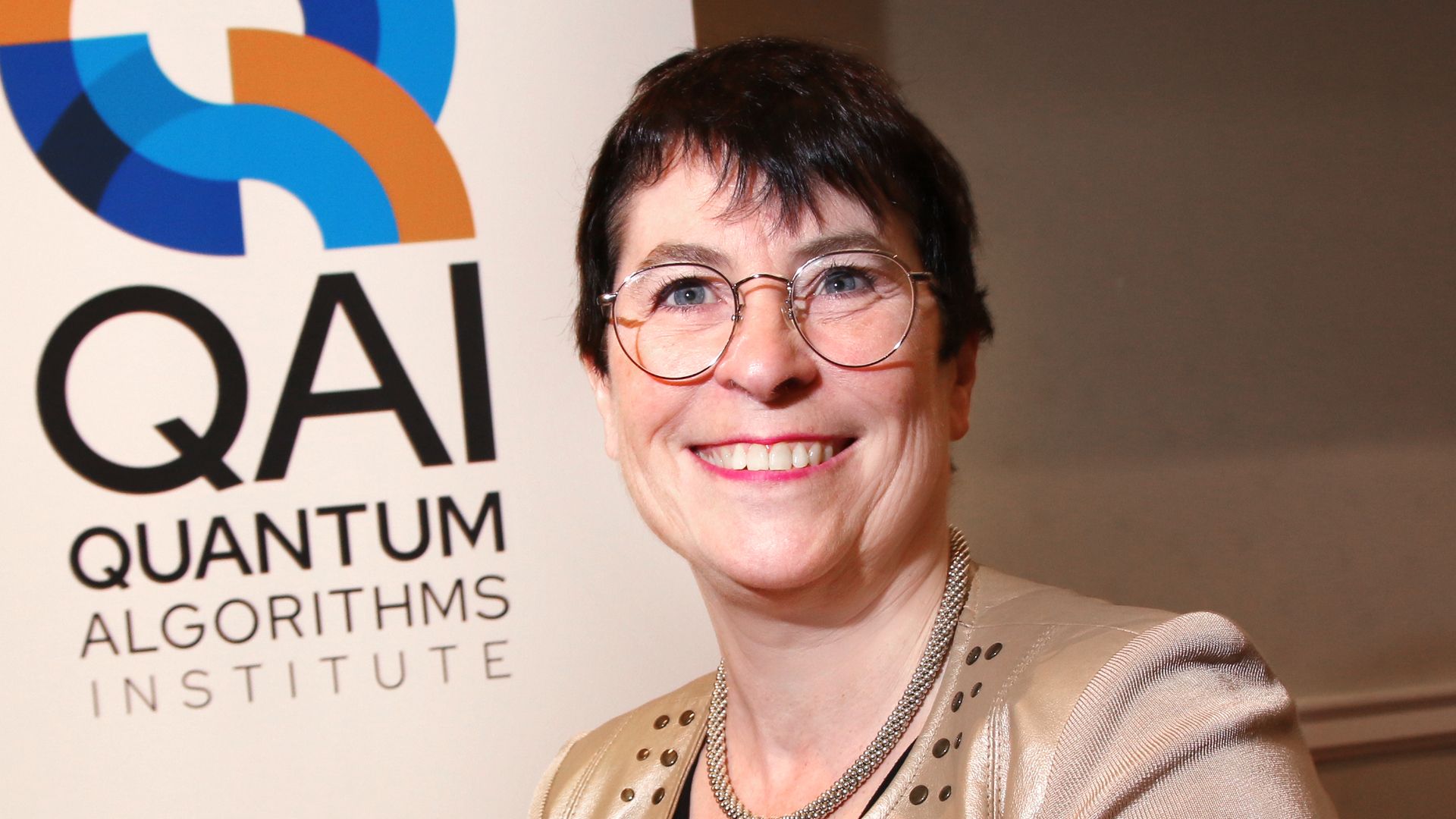
“Things change on a dime in this sector,” says QAI’s Louise Turner — and B.C. is feeling that shift right now.
The quiet quantum supercluster
Quantum computing often gets filed under “futuristic” or “not yet real,” but the reality in B.C. is far stranger — and far more immediate.
For one, the world’s first commercially available quantum computer was shipped from Burnaby. D-Wave, founded here, launched its first system in 2011.
Vancouver-based Photonic is gaining global attention for its fault-tolerant, silicon-spin approach to distributed quantum computing. OneQubit launched here too. IBM and Microsoft both have quantum-focused teams in the province.
By Turner’s count, B.C. now has around nineteen domestic quantum companies — a remarkable number for a province of five million people. She believes B.C. has one of the highest per-capita concentrations of quantum specialists among countries with national quantum programs, which fits the density of institutions, companies and personnel here.
What’s strange is how few people in the province seem aware of it. Including this writer.
“The number of people who really understand quantum is very small,” Turner said. “And the number who realize B.C. has a quantum cluster is even smaller.” Her organization — QAI — sits at the junction of industry, academia and government. It exists largely to help companies understand where quantum is going and how they might use it.
And where quantum is going is closer than most people think. Turner believes the next three to five years will bring breakthroughs that feel sudden, even though they’re the product of decades of incremental progress. These advances will not look like quantum laptops, but rather targeted performance gains in fields such as chemistry, material science, supply-chain optimization, environmental modelling and secure communications.
To make it concrete, she pointed to molecular simulation. Classical supercomputers can simulate aspects of large molecules, but doing so at high fidelity, across full dynamics and without prohibitive cost quickly becomes computationally explosive. Quantum systems are designed to operate on the same mathematical scaffolding as nature itself, so modelling complex biomolecules becomes far more tractable.
“Once you can simulate these things efficiently,” Turner said, “everything changes.”
AI’s parallel explosion
If quantum is the quiet revolution, AI is the loud one — though not always for the reasons we assume.
B.C. is often framed as a tertiary AI hub in Canada, behind Montreal and Toronto. But Goehring sees something else: a province that reliably tops the country in applied AI — the kind that solves real-world sector problems rather than building general-purpose models.
“B.C. excels in applied AI,” he said. “Our ability to create market-driven solutions is excellent relative to other jurisdictions.”
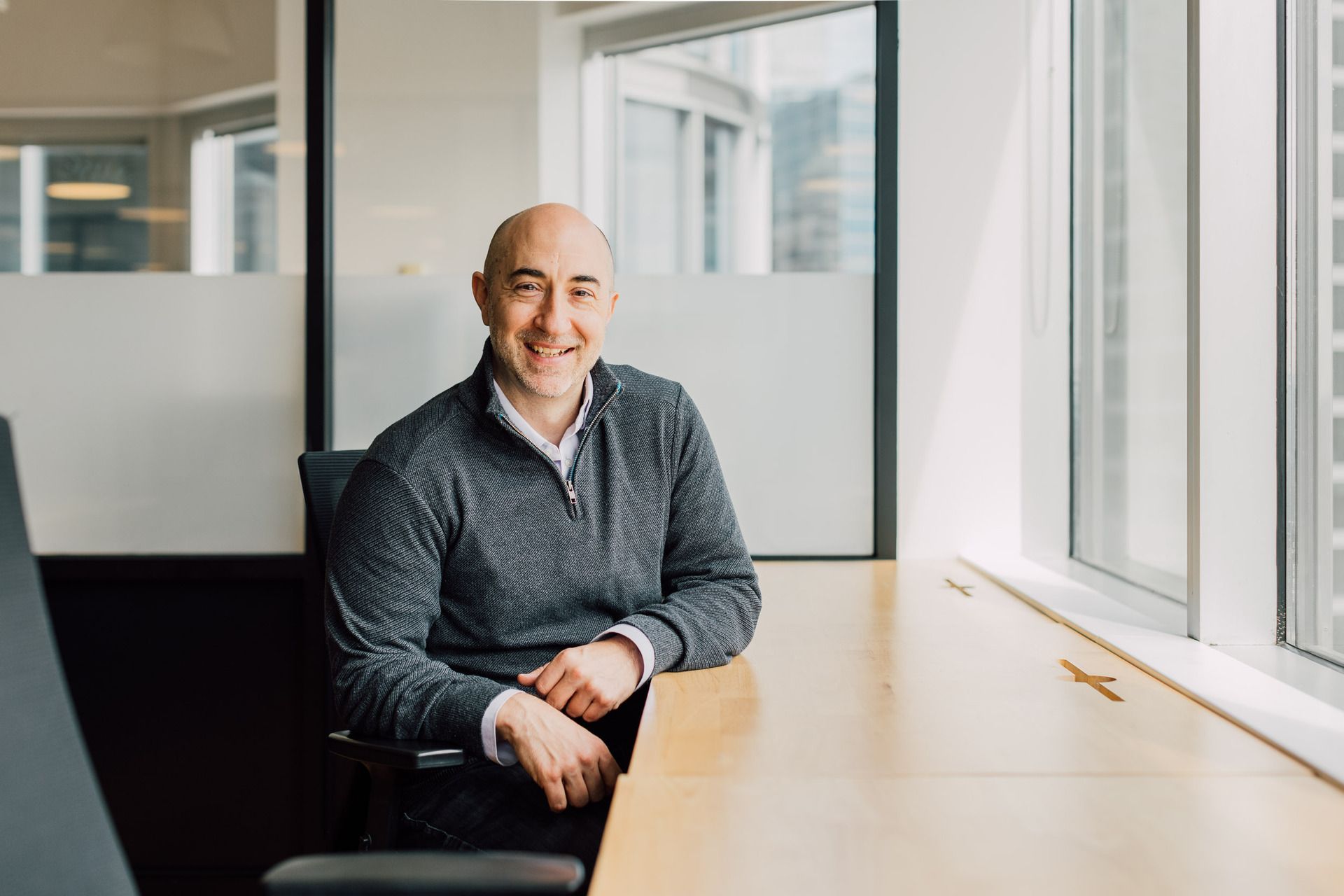
“We excel in applied AI,” says AInBC’s Rob Goehring. “Now the challenge is scaling it.”
The challenge isn’t invention; it’s scaling. Goehring described the recurring structural issues: companies that can build strong technical products but struggle to raise growth-stage capital; corporate buyers that are interested in AI but stalled by slow procurement, undefined ROI and risk aversion; and a shortage of scale-up operators — the product managers, sales leaders, regulatory navigators and go-to-market architects who turn research into revenue.
“Many of our companies can build AI,” he said. “The challenge is selling it, scaling it, exporting it.”
And yet, he believes B.C. has a natural advantage: deep expertise in sectors where AI can make immediate, globally relevant contributions. Natural resources, climate and environmental science, health research, genomics and marine technology all create fertile ground for domain-specific AI — the sort that outperforms generic models because it understands the physics and constraints of the actual world.
“B.C. isn’t competing with Silicon Valley on foundation models,” Goehring said. “Where we can lead is domain-specific AI in sectors where Canada already has strengths.”
That’s where AI and quantum begin to intersect.
What Turner and Goehring describe are not two separate revolutions. They’re two technologies converging on the same problem space.
Quantum enhances AI by enabling simulations, optimization and cryptographic capabilities that classical hardware struggles to handle efficiently. AI enhances quantum by providing the control systems, problem-framing tools and hybrid workflows that make quantum usable.
Turner sees this from a scientific lens: quantum-enabled chemistry, optimization and secure networking complement AI’s strengths. Goehring sees it from a commercial one: quantum-grade sensing, photonic networks and secure communication systems will increasingly sit alongside AI systems in climate analysis, health research, natural-resource management and logistics.
Imagine a future where AI models forecast wildfire behaviour; quantum sensors map underground water; quantum tools accelerate drug discovery; and AI systems steer optimization engines built on quantum-derived models — all running on Canadian-controlled compute.
This isn’t science fiction. It’s the emerging technology stack of the 2030s.
But it depends on one thing B.C. hasn’t historically excelled at: adoption.
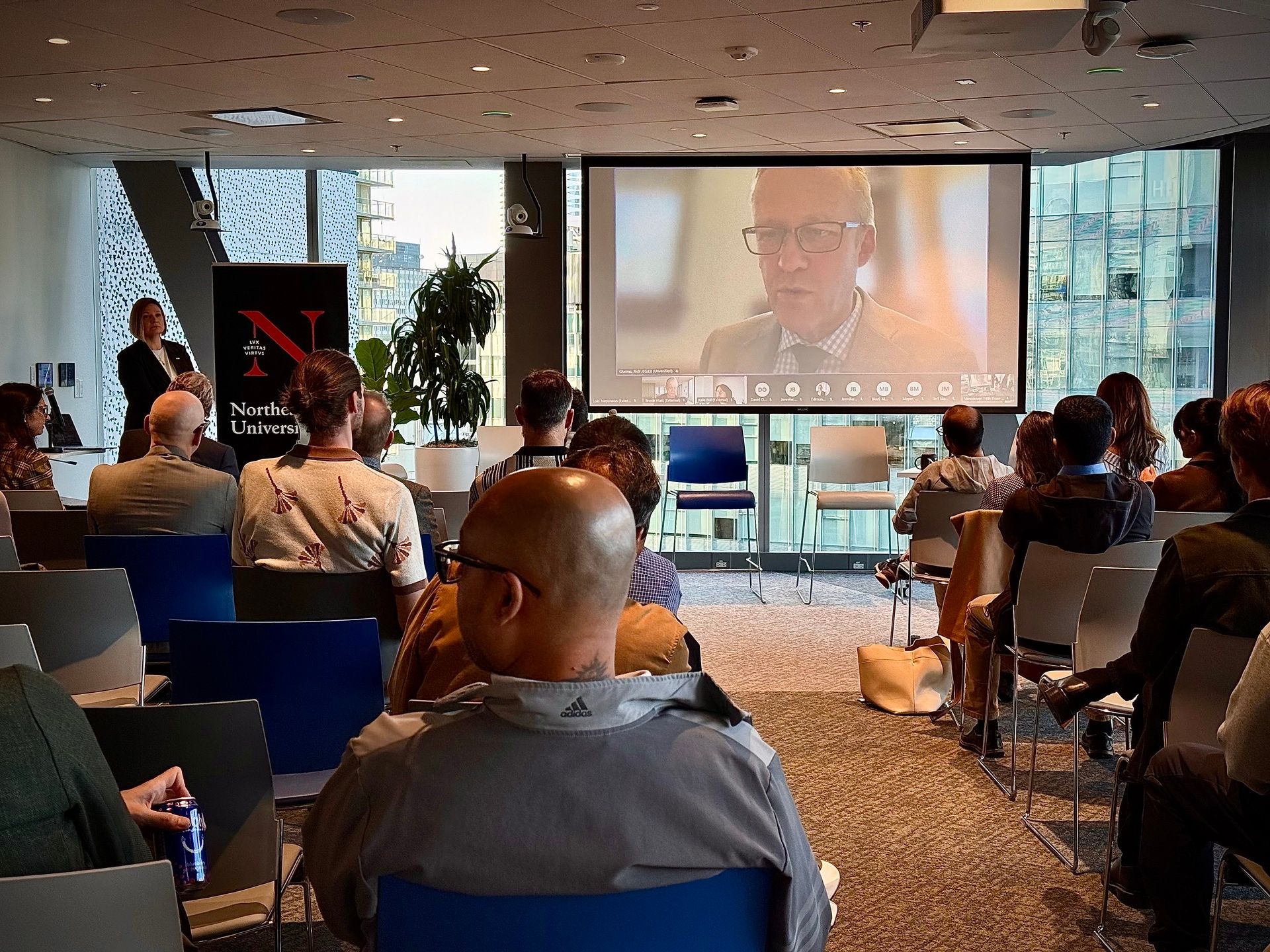
Rick Glumac, B.C. Minister of State for Artificial Intelligence and New Technologies, speaks virtually to a room full of AI enthusiasts at Northeastern University in Vancouver. (Credit: VTJ)
The adoption problem
Frontier technologies all face the same riddle: how do you get organizations to adopt something they don’t yet understand?
In AI, the barrier is risk aversion. “When I talk to data teams,” Goehring said, “what often holds them back is the lack of ROI metrics and risk aversion.”
In quantum, the barrier is disbelief. “People think quantum is science fiction,” Turner said. “We need them to understand it’s real, and it’s coming.”
Adoption matters because early movers in AI and quantum will shape their industries for years. And B.C. is unusually well-positioned to become a testbed. It has world-leading forestry and mining operators, strong climate-tech clusters, a robust health-research community, multiple quantum companies, a dense applied-AI ecosystem and ministries willing to run pilots.
But the window is tight.
Both Turner and Goehring converge on a three-to-five-year horizon. That’s the period in which quantum hardware will grow meaningfully more capable, AI adoption will accelerate across sectors, sovereign compute will come online, and Canada’s national strategy will take shape.
“Three years is not unreasonable,” Turner said. “Things change on a dime in this sector.”
Goehring’s version: “We need to think bigger and move with urgency.”
If B.C. treats this moment as a sprint, it can lead. If it hesitates, others will seize the opportunity.
Beneath everything — budgets, hardware, strategy — lies the workforce.
Quantum’s workforce gap is especially stark. “The number of people who really understand quantum is very small,” Turner said. She added that quantum roles aren’t even categorized properly in national occupational systems, making planning difficult. Her ambition is twofold: upskill engineers and developers into quantum-capable practitioners, and build a long-term pipeline from high school through university and into industry.
“It’s going to be a fun, exciting, well-paid sector,” she said. “But we need to build the people.”
In AI, the issue is different. B.C. has researchers. What it lacks is AI operators — the people who integrate, scale, deploy and commercialize models.
This is the quiet crisis that could define B.C.’s trajectory.
The sovereignty question
Underlying the adoption and talent challenges is a simpler, more fundamental concern: sovereignty.
Quantum threatens today’s cryptographic systems; AI raises issues of data governance and dependency; and both expose Canada’s reliance on foreign cloud providers and foreign capital. That makes sovereign compute, quantum-safe infrastructure and Canadian-controlled data frameworks essential.
“The national strategy has to address data access, privacy-safe frameworks and sovereign control,” Goehring said.
Turner echoed the same point: “We need to get the economy ready for post-quantum security.”
Sovereignty is no longer a policy footnote. It’s the substrate of the next economy.
For decades, B.C. was defined by extraction and lifestyle. Tech was a nice-to-have. Research was prestige. Startups were sporadic.
But slowly and quietly, B.C. has built one of the world’s strongest applied-AI clusters and one of its most advanced commercial-quantum clusters. It has three major universities in close proximity, sovereign-compute players, dense concentrations of photonics and biotech expertise, and a government increasingly invested in innovation.
This isn’t normal, and it isn’t accidental. It is the early architecture of a different kind of economy.
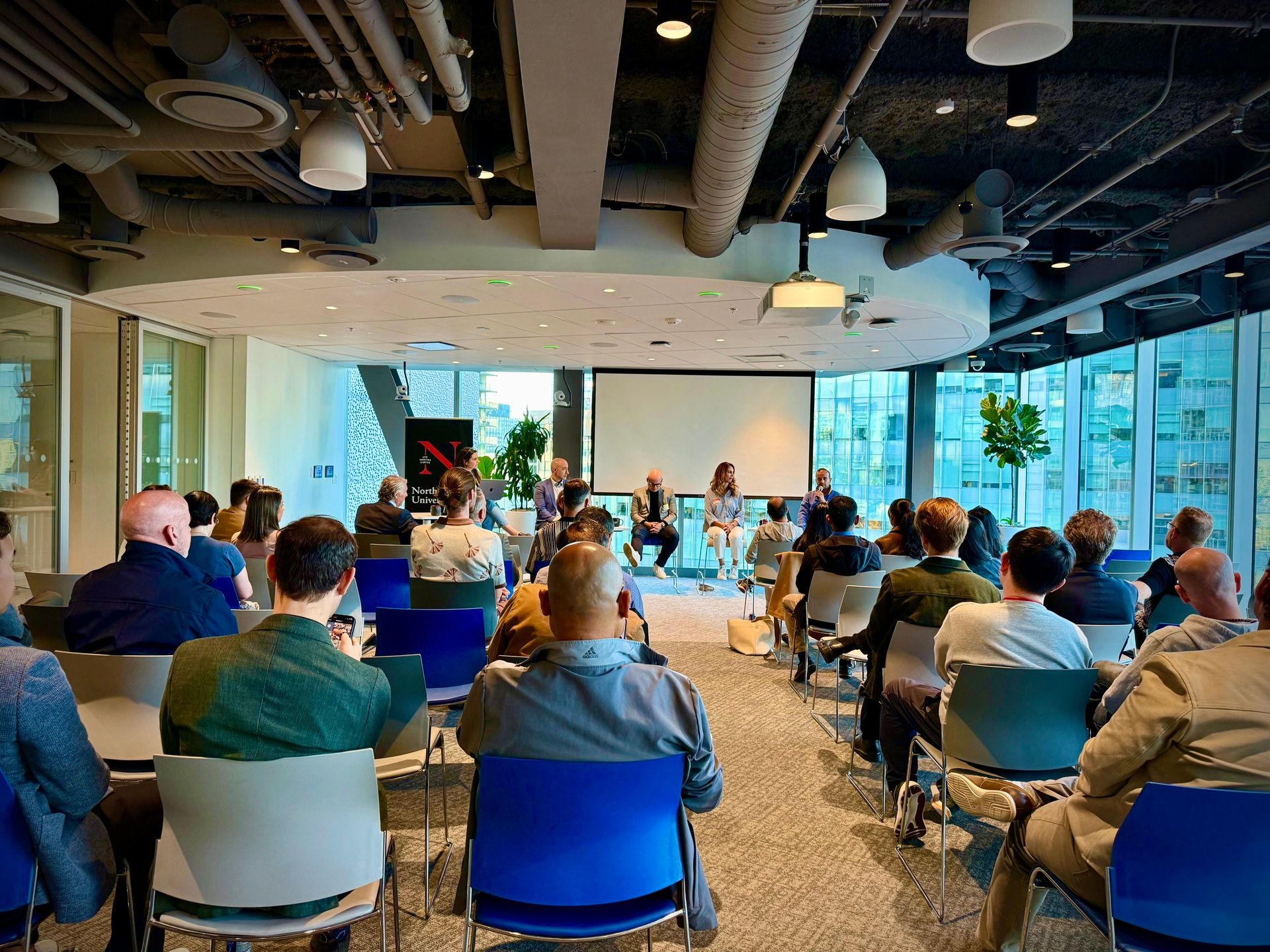
AI leaders convened in downtown Vancouver in October to reflect on their experience at Montreal’s ALL-IN conference. (Credit: VTJ)
If B.C. gets this right, the province in 2028 will look different. AI systems will likely be running in hospitals, forestry operations and environmental programs. Quantum prototypes may be in early-stage use for material-science research, mining optimization or drug-discovery workflows. Sector-led innovation clusters will be more defined. The quantum workforce will be larger and more structured. AI operators will be more common in companies of all sizes. Sovereign compute will be running meaningful workloads. Quantum-safe communication pilots will be underway. And the cultural posture will be one of adoption and speed, not hesitation.
These changes won’t require everyone to understand quantum mechanics or learn to train AI models. They will require a shared understanding that AI and quantum will fundamentally shape the next economy.
“Suspend your disbelief”
Turner ended our conversation with a line that deserves to be taped to the doors of B.C.’s boardrooms.
“Suspend your disbelief.”
“You don’t need to understand how quantum works,” she said. “You just need to understand that a new kind of computing is coming.”
Goehring added the practical counterweight: “We need demand-driven pathways. A dollar of revenue is worth more to a company than a dollar of grant money.”
Together, they’re pointing to a simple truth: the future won’t be built by watching others innovate. It will be built by early adopters willing to move before everything is perfect.
British Columbia has the talent, the companies, the research density and the global positioning — and uniquely, strengths in both AI and quantum at the moment the world needs both.
The only remaining question is whether we move fast enough. Because the map of the next economy is being drawn right now. And B.C. is standing at the edge of it.
